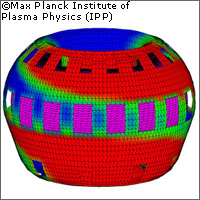Researchers develop code to ensure plasma stability of ITER reactor
Researchers at the Max Planck Institute of Plasma Physics have developed a special code to calculate kinks in the test reactor of the International Thermonuclear Experimental Reactor (ITER) project. This should ensure the stability of the reactor. The experimental fusion reactor, which is to be located in Cadarache, southern France, will attempt to reproduce on Earth the nuclear reactions that power the Sun and other stars. To produce this energy, the reactor will need to heat hydrogen plasma to temperatures exceeding 100 million °C. It is estimated that the reactor could produce, in lasting pulses, fusion power of some 500 megawatts. Because the temperature of the plasma will be so high, it must be contained within a magnetic field, avoiding any contact with the vessel wall. The way in which plasma particles and the magnetic cage interact can, however, cause bumps and dents (kinks) to appear on the outside of the magnetic field. These kinks impair the confinement of the plasma, thus reducing the fusion yield. In ITER they would, according to the researchers' calculations, occur in the very plasma states that scientists are counting on to develop a reactor capable of continuous operation. There are, however, several possible remedies to the problem: one is using a superconducting wall, which can stabilise the plasma and offset the kinks. Another possibility is a 'normal' steel wall, which could slow down the formation of kinks - from microseconds to milliseconds. This makes the process slow enough for an automatic feedback system to intervene. Weak electric control currents flowing in small magnet coils attached to the wall could also be used to capture and eradicate the bumps and dents before they grow. For these remedies to be effective though, researchers must be able to describe and calculate the processes precisely. This is where the newly developed Starwall code comes in. For the first time, the code provides readings about the plasma and vessel walls in all three spatial dimensions. Previously, only two spatial dimensions were calculated. This is because the ring-shaped plasma vessel, the magnetic cage, and the plasma, are of axisymmetric form and no changes occur around the ring. However, when describing the electromagnetic interactions between the plasma and vessel wall, researchers have to take into account the fact that the wall is not identical everywhere. For example, in some places there are large ports for making the plasma accessible for heating facilities, pumps and measuring instruments. Exact calculation of kinks in the wall thus requires the inclusion of all three spatial dimensions. The new code is expected to help ensure that the right stability processes are being used. It has already calculated that the ITER reactor could remain stable with plasma pressure that is 50% higher than it could have stood without stabilisation processes.



